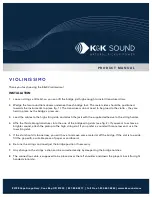
WA-1100/WA-1600 Wavemeter Operating Manual
1 Introduction
08115-M-00 Rev E
1-1
1. Introduction
This section provides general information on the WA-1100/1600 and information on
unpacking and setting up the instrument.
Overview
WA-1100 and WA-1600 Wavemeter systems are instruments designed for simple,
automatic and accurate wavelength measurement of continuous wave (CW) laser
sources. Wavemeter systems count interference fringes produced by the input laser
radiation in a scanning Michelson interferometer and simultaneously count fringes from
a built-in reference laser. The ratio of the fringe counts of the input laser and the
reference laser provides the wavelength of the input laser.
The accuracy of the measured wavelength is dependent on the knowledge of the
reference laser wavelength. The WA-1100 uses a multi-mode HeNe reference laser with
an absolute wavelength accurate to within
±
500 MHz or
±
1 part per million. The WA-
1600 uses a stabilized single frequency HeNe laser that is calibrated to an accuracy better
than
±
50 MHz relative to the Ne
20
atomic line center. This corresponds to a reference
accuracy of ± 0.1 parts per million. Refer to Appendix A for complete specifications.
The WA-1100 and WA-1600 contain a rigid monolithic interferometer made from a
single piece of aluminum and housed in a compact and rugged package. This design
permits these instruments to be less susceptible to misalignment, more robust, faster and
less expensive than the previous generation of WA-1100/1600 and competitive
instruments.
Both the WA-1100 and WA-1600 products have microprocessor based electronics that
allow accurate counting and analysis of interference fringes. The microprocessor
computation automatically corrects for the refractive index of air, using data from built-
in temperature and pressure sensors and converts the resulting measurement to units of
nm, cm
-1
or GHz. The microprocessor also makes it possible for the instrument to
calculate and display the deviation between the measured wavelength and starting point,
or compute the average of up to 128 measurements. Refer to Section 4 for additional
information on the theory of operation.
Introduce laser light into the instrument by attaching your fiber optic cable to the fiber
optic connector on the front of the Instrument. The standard connector is
FC
/
PC
. An
FC
/
APC
connector is available as an option at the time of order.
The ifront panel has controls to review data and review and change parameter values.
Refer to Section 2 for information on the controls and display and setup screens.
The instrument has a built-in bi-directional RS-232 interface and a GPIB interface for
transmitting data and remotely controlling the instrument. Refer to Section 3 for
information on these interfaces and the SCPI communication scheme.
Artisan Technology Group - Quality Instrumentation ... Guaranteed | (888) 88-SOURCE | www.artisantg.com







































